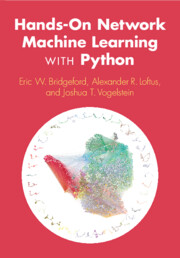
-
Select format
-
- Publisher:
- Cambridge University Press
- Publication date:
- September 2025
- September 2025
- ISBN:
- 9781009405379
- 9781009405393
- Dimensions:
- Weight & Pages:
- Dimensions:
- (244 x 170 mm)
- Weight & Pages:
- 0.82kg, 478 Pages
You may already have access via personal or institutional login
Book description
Bridging theory and practice in network data analysis, this guide offers an intuitive approach to understanding and analyzing complex networks. It covers foundational concepts, practical tools, and real-world applications using Python frameworks including NumPy, SciPy, scikit-learn, graspologic, and NetworkX. Readers will learn to apply network machine learning techniques to real-world problems, transform complex network structures into meaningful representations, leverage Python libraries for efficient network analysis, and interpret network data and results. The book explores methods for extracting valuable insights across various domains such as social networks, ecological systems, and brain connectivity. Hands-on tutorials and concrete examples develop intuition through visualization and mathematical reasoning. The book will equip data scientists, students, and researchers in applications using network data with the skills to confidently tackle network machine learning projects, providing a robust toolkit for data science applications involving network-structured data.
Reviews
‘Networks are everywhere these days. The exponential growth of network data sets demands ever more sophisticated, flexible and scalable modeling techniques. This book provides a concise introduction to basic concepts, mathematical foundations and algorithmic approaches in network analysis. Highly recommended to all practitioners, students and professionals alike.’
Olaf Sporns - Distinguished Professor, Indiana University Bloomington
Contents
Metrics
Full text views
Full text views help Loading metrics...
Loading metrics...
* Views captured on Cambridge Core between #date#. This data will be updated every 24 hours.
Usage data cannot currently be displayed.
Accessibility standard: WCAG 2.1 A
Why this information is here
This section outlines the accessibility features of this content - including support for screen readers, full keyboard navigation and high-contrast display options. This may not be relevant for you.
Accessibility Information
The PDF of this book complies with version 2.1 of the Web Content Accessibility Guidelines (WCAG), covering newer accessibility requirements and improved user experiences and meets the basic (A) level of WCAG compliance, addressing essential accessibility barriers.
Content Navigation
Table of contents navigation
Allows you to navigate directly to chapters, sections, or non‐text items through a linked table of contents, reducing the need for extensive scrolling.
Index navigation
Provides an interactive index, letting you go straight to where a term or subject appears in the text without manual searching.
Reading Order and Textual Equivalents
Single logical reading order
You will encounter all content (including footnotes, captions, etc.) in a clear, sequential flow, making it easier to follow with assistive tools like screen readers.
Short alternative textual descriptions
You get concise descriptions (for images, charts, or media clips), ensuring you do not miss crucial information when visual or audio elements are not accessible.

